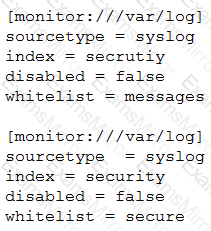special code - Ends in 0d 00h 00m 00s - Coupon code = discmirror
Pass the Splunk Core Certified Consultant SPLK-3003 Questions and answers with ExamsMirror
Exam SPLK-3003 Premium Access
View all detail and faqs for the SPLK-3003 exam
590 Students Passed
93% Average Score
96% Same Questions
What does Splunk do when it indexes events?
A [script://] input sends data to a Splunk forwarder using which method?
Which of the following processor occur in the indexing pipeline?
A customer has three users and is planning to ingest 250GB of data per day. They are concerned with search uptime, can tolerate up to a two-hour downtime for the search tier, and want advice on single search head versus a search head cluster. (SHC).
Which recommendation is the most appropriate?
Consider the scenario where the /var/log directory contains the files secure, messages, cron, audit. A customer has created the following inputs.conf stanzas in the same Splunk app in order to attempt to monitor the files secure and messages:

Which file(s) will actually be actively monitored?
What is the default push mode for a search head cluster deployer app configuration bundle?
When monitoring and forwarding events collected from a file containing unstructured textual events, what is the difference in the Splunk2Splunk payload traffic sent between a universal forwarder (UF) and indexer compared to the Splunk2Splunk payload sent between a heavy forwarder (HF) and the indexer layer? (Assume that the file is being monitored locally on the forwarder.)
The data in Splunk is now subject to auditing and compliance controls. A customer would like to ensure that at least one year of logs are retained for both Windows and Firewall events. What data retention controls must be configured?
What should be considered when running the following CLI commands with a goal of accelerating an index cluster migration to new hardware?

What is the primary driver behind implementing indexer clustering in a customer’s environment?
TOP CODES
Top selling exam codes in the certification world, popular, in demand and updated to help you pass on the first try.
